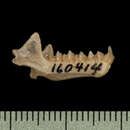pms
nòm ant ël fil


Perception Channels: tactile ; chemical
Other Physical Features: endothermic ; bilateral symmetry
Key Reproductive Features: gonochoric/gonochoristic/dioecious (sexes separate); sexual
Megadermatidae, or false vampire bats, are a family of bats found from central Africa, eastwards through southern Asia, and into Australia. They are relatively large bats, ranging from 6.5 cm to 14 cm in head-body length. They have large eyes, very large ears and a prominent nose-leaf. They have a wide membrane between the hind legs, or uropatagium, but no tail. Many species are a drab brown in color, but some are white, bluish-grey or even olive-green, helping to camouflage them against their preferred roosting environments. They are primarily insectivorous, but will also eat a wide range of small vertebrates.[1]
False vampire bats are relatively large, with combined head and body lengths that range from 65–140 mm (2.6–5.5 in). Their forearm lengths range from 50–115 mm (2.0–4.5 in). They all lack tails. The ghost bat is the largest member of the family. All the species have very large ears with divided tragi. They have long nose-leaves. All species are similar in that they lack upper incisors, though not all species have the same dental formulae.[2] The lesser false vampire bat and greater false vampire bat have a dental formula of 0.1.2.32.1.2.3 × 2 = 28, while the ghost bat, heart-nosed bat, Thongaree's disc-nosed bat, and yellow-winged bat have a dental formula of 0.1.1.32.1.2.3 × 2 = 26.[3][2]
These species are collectively called false vampire due to the old misconception that they were sanguivorous like the true vampire bats. The ghost bat, heart-nosed bat, lesser false vampire bat, and greater false vampire bat feed on insects and small vertebrates; the yellow-winged bat and Thongaree's disc-nosed bat are likely fully insectivorous.[3][2][4] The heart-nosed bat, greater false vampire bat, and the ghost bat are three of the few bat-eating bats in the world.[4][5] All species of this family are nocturnal, with the exception of the yellow-winged bat which is sometimes active in daylight.[2]
Megadermatidae (false vampire bats)
Craseonycteridae (Kitti's hog-nosed bat)
Rhinopomatidae (mouse-tailed bats)
Hipposideridae (Old World leaf-nosed bats)
Rhinolophidae (horseshoe bats)
Internal relationships of the Rhinolophoidea, according to a 2011 study[6] MegadermatidaeMegaderma spasma (lesser false vampire bat)
Megaderma lyra (greater false vampire bat)
Lavia frons (yellow-winged bat)
Cardioderma cor (heart-nosed bat)
Macroderma gigas (ghost bat)
Internal relationships of the Megadermatidae, according to a 2015 study[7]Megadermatidae is a family within the Rhinolophoidea superfamily. Genetic analysis shows that it is the most basal member of the superfamily. It is a monophyletic family of bats, based on genetic analysis.[6]
There is confusion about the relationship of species within Megadermatidae. A 2015 study concluded that, while they did not have enough genetic data to fully resolve these relationships, the two Megaderma species should be in separate genera. The authors of the 2015 paper suggested that the greater false vampire bat, Megaderma lyra, should be renamed as Lyroderma lyra.[7] The recovered cladogram in the 2015 study had relatively low posterior probabilities, however, underscoring the need for future study to achieve higher resolution.[7] Note that Thongaree's disc-nosed bat, Eudiscoderma thongareeae, was not included in this analysis, as it was not described as a new species until 2015.[3]
Megadermatidae is a relatively old family, appearing in the fossil record as early as 37 million years ago.[6] Several fossil species have been described, including:[8]
All Megadermatidae species are evaluated as least concern by the IUCN with the exception of the ghost bat, which is vulnerable, and Thongaree's disc-nosed bat, which is critically endangered.[12][13]
A list of extant species includes,
Family Megadermatidae
Megadermatidae, or false vampire bats, are a family of bats found from central Africa, eastwards through southern Asia, and into Australia. They are relatively large bats, ranging from 6.5 cm to 14 cm in head-body length. They have large eyes, very large ears and a prominent nose-leaf. They have a wide membrane between the hind legs, or uropatagium, but no tail. Many species are a drab brown in color, but some are white, bluish-grey or even olive-green, helping to camouflage them against their preferred roosting environments. They are primarily insectivorous, but will also eat a wide range of small vertebrates.